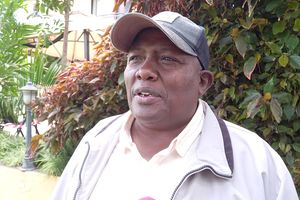Premium
Kenyan gays come together to tell their varied stories
Kevin Mwachiro (L) a member of the gay activist community signs a copy of Invisible - Stories from Kenya's Queer Community, during the book launch at Goethe Institute, Nairobi on February 5, 2014. PHOTO | GERALD ANDERSON
What you need to know:
- You commiserate with the experiences of some of the writers, laugh at the more quirky of their encounters or are emboldened by those who take their situation in a casual, matter-of-fact way
- Even though by the time they emerge many queer persons are not looking for validation of affirmation, the fact that many write warmly about those within the family that accepted them attest to the emotional bulwark this gives
A new book, Invisible, launched in Nairobi at the beginning of the month, is a collection of stories and poems on the experiences of lesbian, gay, bisexual, transsexual and intersexual (LGBTI) people in Kenya. It narrates the varied experiences of members of the gay community when growing up and coming to terms with their orientation.
You commiserate with the experiences of some of the writers, laugh at the more quirky of their encounters or are emboldened by those who take their situation in a casual, matter-of-fact way. Overall, it is touching and evocative in its humanness.
Kenya’s recent discussions on homosexuality, given added impetus by Binyavanga Wainaina’s coming out, is not in isolation. The queer debate is currently taking centre stage across the world, mired in controversy in Russia, hosts of the Winter Olympic Games, and religiously conservative America where it has become a political issue and where President Obama himself was recently forced to take an open stand on the matter. (READ: Binyavanga’s presentation of a missing chapter is a clever strategy)
'ABNORMAL' FEELINGS
Among the themes Invisible brings to the fore are confusion, the struggle to accept oneself, self-love, religious and family conflicts. Some of the writers confess to initially hating themselves, often turning to religion to crush their ‘abnormal’ feelings.
In a bid to change themselves, some gay men reveal how they went to the extent of getting into relationships with women hoping this would make them normal, while others bowed to family pressures to get married, unions that proved unsuccessful and short-lived.
Another strong theme of many of the writers is the feeling of being aberrant and abnormal, which would lead to their being ostracised by society. To resolve this crisis, some saw psychiatrists, others visited religious leaders.
Elias’s rendering of his visit to a psychiatrist is inadvertently hilarious as he tells of the professional’s goggle-eyed confoundedness with his case, being so flummoxed as to invite his fellow doctor to their sessions.
The psychiatrists were often convinced that the men were gay as a result of being raped in childhood, which was not the case, and often ended up being of no help. As another writer pithily put it: “Many counsellors are not well equipped to handle issues of sexual orientation.”
The reactions the writers present from their family members also shows us that there is no single attitude to homosexuality in Kenya. It is varied and nuanced; not everyone is homophobic as is widely believed. Some parents were curious, others afraid they did something wrong in their parenting, others pragmatic and matter-of-fact. Siblings did not take the news uniformly either, some accepting of the news, others being harsh and judgmental.
Even though by the time they emerge many queer persons are not looking for validation of affirmation, the fact that many write warmly about those within the family that accepted them attest to the emotional bulwark this gives.
Jackson tells us how one of his brothers asked why he had not come out to him, sending him a text message saying that he did not care what orientation he was and that he was still his brother. The tender humaneness in such a simple gesture brings tears to your eyes.
The writers captured in the anthology are people of different ages, backgrounds, religions, and from different parts of the country. Indeed, Brizan’s story, ‘Turkanas Can’t be Gay,’ turns the idea that gayness is something ‘taught’ or ‘transmitted’ in urban areas flatly on its head as he was born and bought up in a simple Turkana village.
The poems in the book, while lacking in aesthetic literary merit, nevertheless give voice to the concerns to members of the queer community, telling of the generally repressive and conformist Kenyan society.




